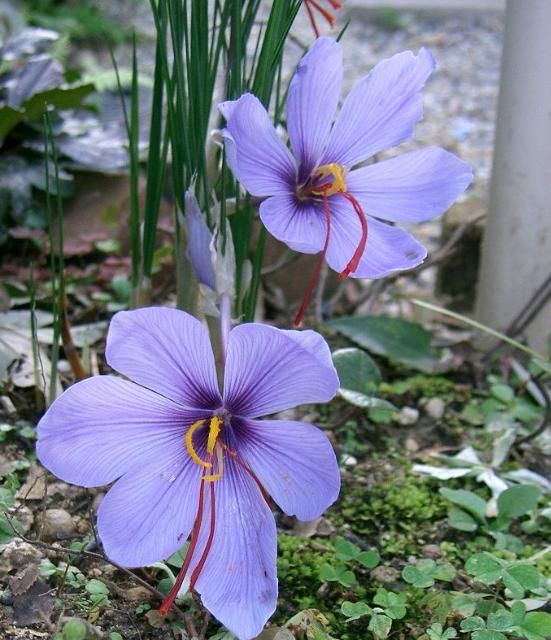Saffron—Crocus sativus L.1
Saffron is not a vegetable, although in some areas of the world the corms of various crocus species are eaten by local peasants. Saffron is one of the world's most expensive spices. The slender dried flower stigmas of the saffron constitute the true saffron of commerce. At one time, some reports placed the wholesale price at around $100 per pound and the retail price at 80 cents per gram, or $365 a pound.
Each blossom yields only three stigmas, which must be picked by hand. Supposedly it takes 210,000 stigmas to make 1 pound of saffron. At one time saffron was popular as a yellowish orange natural dyestuff. Today synthetic dyes have replaced it.

Credit: KENPEI, CC BY-SA 3.0
Description
C. sativus, native to southern Europe and Asia, is a small showy, bulbous perennial, 6–10 inches high, with violet to bluish lily-shaped flowers.
Culture
It is questionable whether or not saffron plants will grow well here in Florida, for reportedly low annual rainfall of 15–18 inches is desirable. Obviously, Florida's annual rainfall greatly exceeds this amount. Heavy rains at flowering time do considerable damage to the blossoms producing the saffron.
In areas of the world where saffron is grown, such as Spain, Portugal, France, and India, an annual yield of 8–10 pounds of dried saffron per acre is obtained in an established planting. Usually the maximum yield occurs in the third year after planting.
Plants are propagated vegetatively by planting the young cormlets that form annually at the base of the bulblike mother corm. While the plants may live and bloom for 10–15 years, few plants are kept longer than 5 years commercially. In Italy saffron is cultivated as an annual, mature corms being set every fall; they are uprooted and replanted every 3 years in France, after 4 years in Spain, and after 10–15 years in India.
Harvesting and Use
When the plants begin to bloom, harvesting commences quickly, for the flowering period may last only 15 days. The triple stigmas are picked by hand daily just as the flower opens. On drying, either in the sun or by artificial heat, the stigmas lose 80% of their weight.After harvest and when fully dried, the saffron must be stored immediately, preferably in tightly covered or sealed tin containers, and protected from light to avoid bleaching. The final product is a compressed, highly aromatic, matted mass of narrow, threadlike dark orange to reddish brown strands about 1 inch long.
True saffron has a pleasantly spicy, pungent, bitter taste and a tenacious odor. Fortunately, a little saffron goes a long way. Besides being steeped in tea, it is used for seasoning many foods such as fancy rolls and biscuits, rice, and fish.


